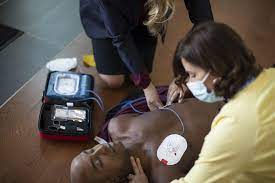Understanding the Role and Functionality of Public Access Fully Automatic AEDs
- Shane Yole
- Aug 13
- 3 min read
In recent years, Automated External Defibrillators (AEDs) have become essential in public health, especially in places where many people gather. These devices can save lives by treating individuals who experience sudden cardiac arrest, a condition that affects nearly 356,000 people annually in the U.S. alone. Among various AEDs, public access fully automatic AEDs are the easiest to use and most widely available. This post will discuss what a public access fully automatic AED is, how it works, and why it is so important in emergencies.

What is a Public Access Fully Automatic AED?
A public access fully automatic AED is a portable device designed to analyze a person's heart rhythm. If the device determines that a shock is necessary, it delivers one automatically. Unlike semi-automatic AEDs, which require a user to press a button, these devices remove barriers for those without medical training, making them incredibly user-friendly.
These AEDs are found in high-traffic areas like airports, shopping malls, schools, and sports facilities. Their placement aims to provide immediate assistance during cardiac arrest, which can improve survival rates significantly. For example, one study found that using an AED within three to five minutes of a cardiac arrest can increase the chance of survival by over 70%.
How Do Fully Automatic AEDs Work?
Fully automatic AEDs are designed to be straightforward. Here’s how they operate:
Power On: When removed from its case, the device powers on automatically in most cases. Some may require pressing a button.
Voice Prompts: The AED gives clear, step-by-step instructions. This guidance is crucial, especially for bystanders unfamiliar with AED operation.
Electrode Pads: The user applies adhesive electrode pads to the patient’s bare chest. These pads are crucial for the AED to analyze the heart’s rhythm.
Heart Rhythm Analysis: The AED analyzes the heart’s rhythm swiftly, in just a few seconds.
Shock Delivery: If a shockable rhythm is detected, the device will instruct that a shock is advised and deliver it automatically. If a shock is not needed, it will prompt the user to continue CPR until emergency services arrive.
Continuous Monitoring: The AED keeps monitoring the patient’s condition and provides further instructions as needed.
This simple process aims to minimize confusion and maximize the chance of survival for cardiac arrest victims.
The Importance of Public Access AEDs
The presence of public access fully automatic AEDs can transform emergency situations. Here’s why they are so vital:
1. Increased Survival Rates
Studies indicate that survival rates jump significantly when an AED is used within the first few minutes of a cardiac arrest. Locations with public access AEDs can see survival rates as high as 50% or more when a defibrillator is used promptly.
2. Empowering Bystanders
Public access AEDs enable ordinary citizens to act decisively during emergencies. With the automatic features and vocal instructions, anyone can operate these devices, filling the gap until professional help arrives. This empowerment is critical since 70% of cardiac arrests occur outside the hospital.
3. Community Preparedness
When communities have readily accessible AEDs, they foster a culture of readiness. This encourages training in CPR and AED usage. For instance, studies have shown that communities that provide AED training see an increase in CPR training by 20%.
4. Reducing Emergency Response Times
With AEDs in public areas, emergency responders can concentrate on delivering advanced care, rather than searching for a defibrillator. This efficiency is vital; each minute that passes without defibrillation decreases the chances of survival by about 10%.
Challenges and Considerations
Public access fully automatic AEDs, while invaluable, face challenges that need to be addressed:
1. Maintenance and Accessibility
Regular maintenance is crucial for ensuring these devices are operational. Communities must have clear protocols for checking and updating AEDs, including battery replacements and ensuring visibility and accessibility.
2. Public Awareness
Many individuals still lack awareness of where public access AEDs are located. Community education, including informational campaigns, can help raise awareness, ensuring more people know how to act when emergencies occur.
3. Training Opportunities
Even though fully automatic AEDs are easier to use, additional training can bolster confidence and effectiveness. Community training sessions on CPR and AED operation can prepare more individuals to respond to emergencies effectively.
Final Thoughts
Public access fully automatic AEDs are vital in emergency response, offering life-saving assistance to those experiencing sudden cardiac arrest. Their user-friendly design and strategic placement in public spaces help ensure help is available when seconds count.
As communities continue to focus on health and safety, enhancing awareness, ensuring accessibility, and promoting training will increase the life-saving potential of these devices. Knowing where an AED is located and how to use it can make a significant difference in emergency situations. Let's work together to create a safer environment for everyone.










Comments